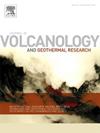Effects of cohesion and viscosity on lava dome growth following repose
IF 2.4
3区 地球科学
Q2 GEOSCIENCES, MULTIDISCIPLINARY
Journal of Volcanology and Geothermal Research
Pub Date : 2024-09-29
DOI:10.1016/j.jvolgeores.2024.108196
引用次数: 0
Abstract
Lava domes result from effusive eruption of high viscosity lava. These viscous lava extrusions range in shape from flat-topped domes with small height-to-width aspect ratios, to spine-like columns exhibiting large height-to-width aspect ratios. A primary control on morphology during early dome growth is thought to be the variation in rheological characteristics of extruded material. In this work, we present new scaled analogue models of lava dome growth that consider extrusion of a frictional plastic upper-conduit plug followed by viscous magma. We simulate the brittle plug using a sand-plaster mixture, the cohesion of which is varied by plaster content. We model the magma using sugar syrup, the viscosity of which is controlled by the weight percent of added crystalline sugar. The models both qualitatively and quantitatively reproduce part of the spectrum of natural dome morphology not previously obtained in most past analogue modelling studies. Model aspect ratios of 0.02 to 0.9 capture approximately 90 % of the reported aspect ratio variation in nature. Increasing plug cohesion results in extrusions with higher aspect ratios and spinier morphologies. Low viscosity fluid typically erupts through the brittle dome, whilst high viscosity fluid tends to promote endogenous growth or emerge as exogenous lobes. Particle Image Velocimetry shows that fracture localisation at the dome surface is cohesion-dependent, and eruption of fluid follows shear fractures within the dome. Where fluid remains contained within the dome, we see lateral spread leading to a wider and flatter dome morphology. Evolution of lava dome morphology, deformation, and associated hazards is guided by the complex rheological properties of the extruded material; we suggest that during episodic dome growth, these properties are largely defined in the conduit prior to their eruption.
内聚力和粘度对熔岩穹丘在静止后生长的影响
熔岩穹丘是高粘度熔岩喷出的结果。这些粘性熔岩挤出物的形状各异,有的呈高宽比较小的平顶圆顶,有的呈高宽比较大的棘状柱体。在早期穹隆生长过程中,对形态的主要控制被认为是挤出材料流变特性的变化。在这项工作中,我们提出了熔岩穹隆生长的新比例模拟模型,该模型考虑了摩擦塑性上导管塞挤出后粘稠岩浆的情况。我们使用砂-石膏混合物模拟脆性栓塞,其内聚力随石膏含量而变化。我们使用糖浆模拟岩浆,其粘度由添加的结晶糖的重量百分比控制。这些模型定性和定量地再现了自然穹顶形态的部分频谱,这在以往大多数模拟模型研究中都没有得到过。模型的长宽比从 0.02 到 0.9,捕捉了自然界中约 90% 的长宽比变化。塞子内聚力的增加导致挤出物具有更高的纵横比和更尖锐的形态。低粘度流体通常通过脆性穹顶喷发,而高粘度流体则倾向于促进内生增长或以外生叶的形式出现。粒子图像测速仪显示,穹顶表面的断裂定位与内聚力有关,流体的喷发是沿着穹顶内的剪切断裂进行的。在流体仍被控制在穹顶内的情况下,我们看到横向扩散导致穹顶形态更宽更平。熔岩穹丘形态、变形和相关危害的演变受挤出材料复杂流变特性的影响;我们认为,在偶发性穹丘生长过程中,这些特性在喷发前已在导管中基本确定。
本文章由计算机程序翻译,如有差异,请以英文原文为准。
求助全文
约1分钟内获得全文
求助全文
来源期刊
CiteScore
5.90
自引率
13.80%
发文量
183
审稿时长
19.7 weeks
期刊介绍:
An international research journal with focus on volcanic and geothermal processes and their impact on the environment and society.
Submission of papers covering the following aspects of volcanology and geothermal research are encouraged:
(1) Geological aspects of volcanic systems: volcano stratigraphy, structure and tectonic influence; eruptive history; evolution of volcanic landforms; eruption style and progress; dispersal patterns of lava and ash; analysis of real-time eruption observations.
(2) Geochemical and petrological aspects of volcanic rocks: magma genesis and evolution; crystallization; volatile compositions, solubility, and degassing; volcanic petrography and textural analysis.
(3) Hydrology, geochemistry and measurement of volcanic and hydrothermal fluids: volcanic gas emissions; fumaroles and springs; crater lakes; hydrothermal mineralization.
(4) Geophysical aspects of volcanic systems: physical properties of volcanic rocks and magmas; heat flow studies; volcano seismology, geodesy and remote sensing.
(5) Computational modeling and experimental simulation of magmatic and hydrothermal processes: eruption dynamics; magma transport and storage; plume dynamics and ash dispersal; lava flow dynamics; hydrothermal fluid flow; thermodynamics of aqueous fluids and melts.
(6) Volcano hazard and risk research: hazard zonation methodology, development of forecasting tools; assessment techniques for vulnerability and impact.

 求助内容:
求助内容: 应助结果提醒方式:
应助结果提醒方式:


